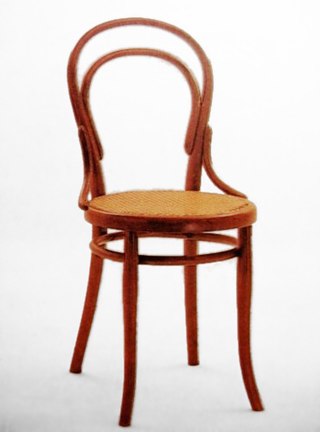
Inter IKEA Systems B.V., trading as IKEA, is a Swedish multinational conglomerate that designs and sells ready-to-assemble furniture, kitchen appliances, decoration, home accessories, and various other goods and home services. Started in 1943 by Ingvar Kamprad and currently legally headquartered in the Netherlands, IKEA has been the world's largest furniture retailer since 2008. The brand used by the group is derived from an acronym that consists of the founder's initials, and those of Elmtaryd, the family farm where he was born, and the nearby village Agunnaryd.
Hans Jørgensen Wegner was a Danish furniture designer. His work, along with a concerted effort from several of his manufacturers, contributed to the international popularity of mid-century Danish design. His style is often described as Organic Functionality, a modernist school with emphasis on functionality. This school of thought arose primarily in Scandinavian countries with contributions by Poul Henningsen, Alvar Aalto, and Arne Jacobsen.

A knock-down kit is a collection of parts required to assemble a product. The parts are typically manufactured in one country or region, and then exported to another country or region for final assembly.

The No. 14 chair is the most famous chair made by the Thonet chair company. Also known as the 'bistro chair', it was designed by Michael Thonet and introduced in 1859, becoming the world's first mass-produced item of furniture. It is made using bent wood (steam-bending), and the design required years to perfect. With its affordable price and simple design, it became one of the best-selling chairs ever made. Some 50 million No. 14s were sold between 1859 and 1930, and millions more have been sold since.

David Roentgen, was a famous German cabinetmaker of the eighteenth century, famed throughout Europe for his marquetry and his secret drawers and poes and mechanical fittings. His work embraces the late Rococo and the Neoclassical styles.

Cardboard furniture is classified as furniture designed and made from corrugated fibreboard, heavy paperboard, honeycomb board, fibre tubes or a combination of these materials. Cardboard furniture is misleading, since "cardboard" is a depreciated term, describing mainly corrugated cardboard, but not being sufficiently specific to describe the various forms of paper-based boards used today in order to make furniture.

Michael Thonet was a German-Austrian cabinet maker, known for the invention of bentwood furniture.

James Irvine was a British industrial designer who created furniture and product designs for many well known companies and brands such as Artemide, B&B Italia, Cappellini, Foscarini, Ikea, Magis, Muji, Thonet, and WMF. He once described the product designer's job as “the work of an unknown hero.”

Stefan Diez is a German industrial designer whose Munich-based studio, DIEZ OFFICE, develops furniture, accessories, and exhibition designs.

Danish modern is a style of minimalist furniture and housewares from Denmark associated with the Danish design movement. In the 1920s, Kaare Klint embraced the principles of Bauhaus modernism in furniture design, creating clean, pure lines based on an understanding of classical furniture craftsmanship coupled with careful research into materials, proportions, and the requirements of the human body.
Home Reserve, LLC, is a furniture manufacturing company headquartered in Fort Wayne, Indiana, US. The company manufactures ready-to-assemble furniture and operates an e-commerce site in which sales are made direct to its customer base.

Louise Brigham was an American early-20th-century designer and teacher. She was a pioneering champion of the use of recycled materials in furniture design. A system she invented for building furniture out of packing crates represents one of the earliest to adopt a modular approach to the design of individual units. She also founded one of the earliest ready-to-assemble furniture companies, as well as the Home Thrift Organization (HTA) to teach woodworking to New York City boys. In 1940, she received a medal from the HTA in honor of her quarter century of service to the organization.

The IKEA effect is a cognitive bias in which consumers place a disproportionately high value on products they partially created. The name refers to Swedish manufacturer and furniture retailer IKEA, which sells many items of furniture that require assembly.

Modern Gothic, also known as Reformed Gothic, was an Aesthetic Movement style of the 1860s and 1870s in architecture, furniture and decorative arts, that was popular in Great Britain and the United States. A rebellion against the excessive ornament of Second Empire and Rococo Revival furniture, it advocated simplicity and honesty of construction, and ornament derived from nature. Unlike the Gothic Revival, it sought not to copy Gothic designs, but to adapt them abstract them, and apply them to new forms.

Emeco is a privately held company based in Hanover, Pennsylvania. The Emeco 1006, known as the Navy Chair, has been in continuous production since the 1940s. Today, Emeco manufactures furniture designed by notable designers and architects such as Philippe Starck, Norman Foster, and Frank Gehry.

Billy is a bookcase sold by the Swedish furniture company IKEA. It was developed in 1979 by the Swedish designer Gillis Lundgren and IKEA have sold over 140 million units of the bookcases worldwide. Its popularity and global spread has led to its use as a barometer of relative worldwide price levels.
Gillis Lundgren was a Swedish furniture designer and the fourth employee of IKEA. He designed the Billy bookcase of which over 60 million have been produced.
FDB Møbler is a Danish furniture company established in 1942. It was formerly a subsidiary of FDB. Børge Mogensen served as the design studio manager and many of his designs are sold by the company. Mogensen was succeeded Poul M. Volther (1950–55), Ejvind A. Johansson (1956–58), and Jørgen Bækmark (1958–67).

A furniture retailer, furniture store or furniture shop is a retail businesses that sells furniture and related accessories. Furniture retailers usually sell general furniture, seats and upholstered suites, and specialised items produced for a commission. They may sell a range of styles to suit different homes and personal tastes, or specialise in particular styles like retro style furniture.

A furniture screw can refer to any type of screw used on furniture. Different types of screws have different uses in furniture.















